Table of Contents
In the “My Characters” database you can record and develop the characters of your story.
You suddenly discovered something illogical in your story, or a great idea arose that requires a few changes earlier in your story? It’s time to start searching, but, if you mentioned your character without using their actual name, you will have to search for clues to find them in your text.
Though not, of course, if you have entered them into the “My Characters” database.
Create a new character database for your story by clicking on the  icon in the toolbar .
icon in the toolbar .
Any document can link to an existing “My Characters” database, but to create a new one your text must be saved as a “project.”
If your document is already a project, when you click on the icon the database will be automatically created for you.

Papyrus Author asks if you would like to create or link a character database
If your text is not a project, you will be asked if you would like to create a database, or link to an existing one.
The same thing will happen if you click on “Create New” in the “Characters” tab in the Navigator Display or go through the menu option “Author”→”My Characters.”
This allows you to create vivid characters and ensures you won’t lose track of them.
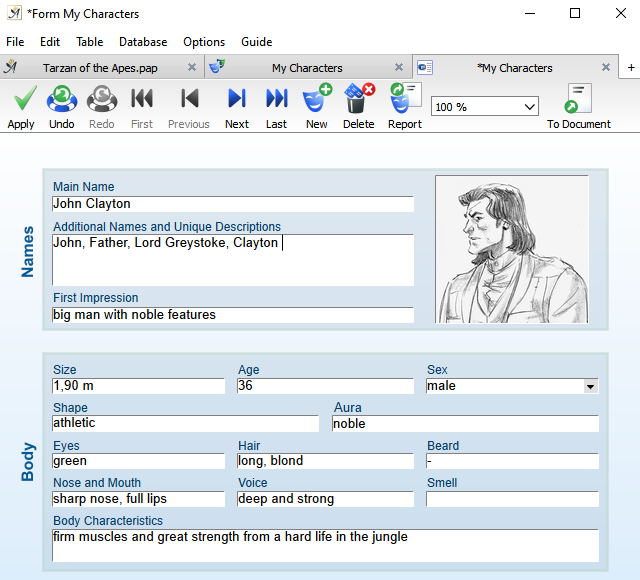
The character page for the example character “John Clayton”
The special feature is that the characters in your database will be automatically linked to the appropriate text passage.

The names are highlighted with a color. These are the characters that have been stored in your character database. You can click them to access their unique pages
This link, named “Link to ‘My Characters’,” goes from a spot in your text directly to your data entry.
This is unique, so again: It is not simply a hyperlink from the text to another spot in the text, but rather a jump to a specific character’s sheet in your “My Characters” database. In this case the character page of the corresponding protagonist.
By double-clicking on this text passage, you will open the linked record in your “My Characters” database. From there, you can look up the description of your character and add to it, if needed.
Linking a Text to an Existing “My Characters” Database
In order to link your story to an existing “My Characters” database, you need to tell Papyrus Author which database your story belongs to.
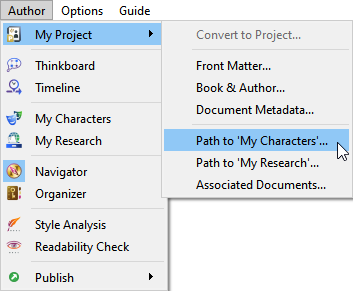
Create a new “My Characters” database, or link to an existing one
For every story without a “My Characters” database, you can create a new one by clicking on the  icon in the toolbar or by going to “Author” → “My Characters” . A database will then be created and automatically linked to your text.
icon in the toolbar or by going to “Author” → “My Characters” . A database will then be created and automatically linked to your text.
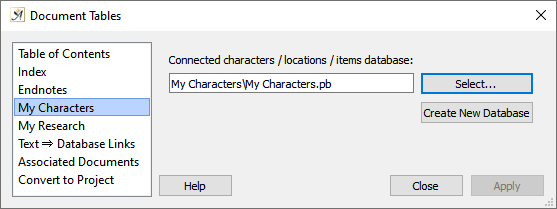
You can link or create character databases in the “My Characters” dialog
If you would like to link another, already existing database to your text (for a sequel, for example), you can do this in the “My Characters” dialog (under “Path to ‘My Characters’…” from either the “Author” → “My Project” menu or “Document” → “Indices and Directories”).
In the dialog, choose the database you would like to link your story to.
If you decide to create your own character database from scratch, you need to make sure you have at least one field as the name field in order to link it with your text (usually a field called “Name”). To add or edit fields to your table, go to the menu “Database” → “Field Properties.” In the tab “Name Type”, set the “Data Type” to “Auto-link names.”
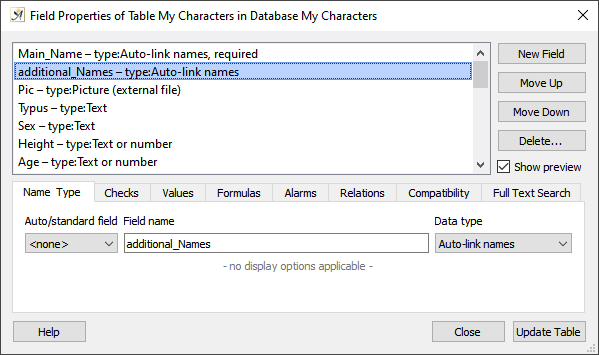
You can create your custom character database with different fields
“My Characters” Dialog
In this dialog, as mentioned above, you can create a new character database for your text or choose one that already exists and link it to your text.

The “My Characters” dialog for creating or linking to character databases
Please be aware that you cannot just add any database of your choice to your text–the structure of the tables for characters, items, and locations must be the same as the original and the first fields must be marked as auto-link fields.
Which Character in Which Chapter? (Link to ‘My Characters’)
Papyrus Author searches your story for every place where you have referred to a character and creates a link between this place in the text and your “My Characters” database.
You will then be able to see which chapters your character can be found in via the Navigator (and how often).
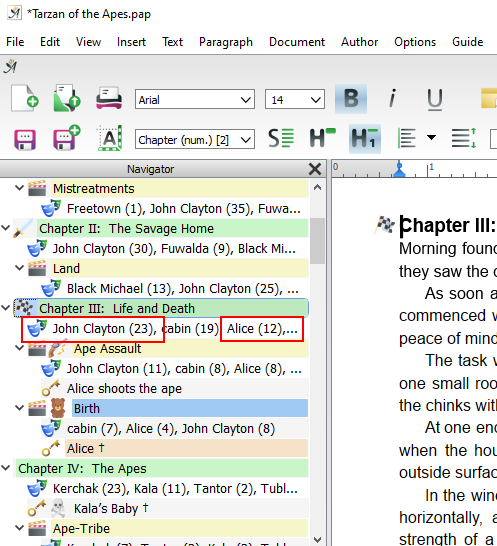
In this example, you can see in the navigator, that in Chapter III, John Clayton’s name appears 23 times, Alice appears 12 times and so on
Papyrus Author uses the names in your character database to find these places in the story where your characters appear.
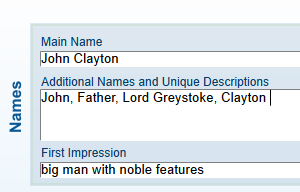
All names and pseudonyms under which the character will be found
Papyrus Author looks up not only the character’s main name, but also any additional names and pseudonyms entered under “Additional Names and Descriptions”. All descriptions will be understood by Papyrus Author as “hits” and any text passage in which they appear will be linked to your “My Characters” database.
Simply enter all names and descriptions, which you would like detected and linked, in the “Additional Names and Unique Descriptions” field, separating each one with a comma (either with or without a space).
In both the “Main Name” and “Additional Names and Unique Descriptions” fields you are allowed to use names consisting of more than one word, e.g. the “Black Widow” (the name can be up to four words long).

“John” as well as “Clayton” will reference the same character and link to the same character page, if you entered them both
For the character “Lucifer,” for example, the names “Devil” and “Satan” should also be entered in the “Additional Names” field–everything you will use in your text. Each time one of these words comes up, Papyrus Author will know that this character is present in this chapter or scene.
Manually Link Text Passages to Your “My Characters” Database
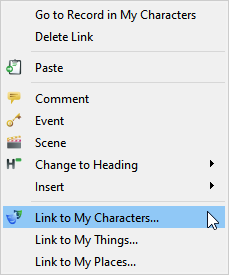
You can link text passages to character database entries manually
It’s also possible to link text passages to your database entries manually.
To do this, simply place your cursor on the word in your text, right-click to open the context menu, and choose “Link to My Characters…”
This text passage will then be linked to the appropriate data entry in your “My Characters” database (even when Papyrus Author would not be able to detect the character automatically).
Your manually created “Link to My Characters…” will still remain intact when your links are updated.
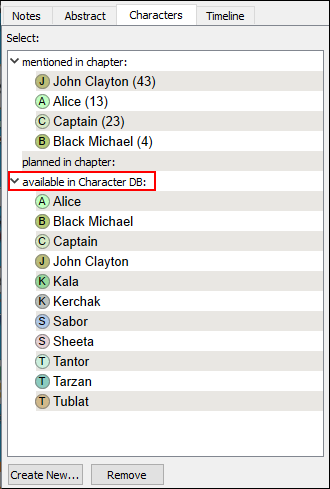
The Navigator Display “Characters” tab will show which characters have been mentioned, which are planned and which are available.
In the Navigator Display “Characters” tab you will find a list of all the characters that appear in that chapter and, if you wish, how often they appear.
You can also use this dialog to plan which characters you would like to include in the chapter.
Under “available in Character DB” you can expand a list of all the existing characters in your database.
Use your mouse to drag and drop the characters you want into the “planned in chapter” list. You can “Remove” them again with the button at the bottom of the column.
If a new character comes to your mind while writing, you can use the “Create New…“ button to directly jump to the “My Characters” database and enter your new character.
In the ![]() “Navigator Options” (accessible by right clicking the Navigator Display in the bottom toolbar) you can decide which characters should be shown in the Navigator (as well as in the Timeline tab).
“Navigator Options” (accessible by right clicking the Navigator Display in the bottom toolbar) you can decide which characters should be shown in the Navigator (as well as in the Timeline tab).
The colors in the circles represent the characters in the Timeline Window.
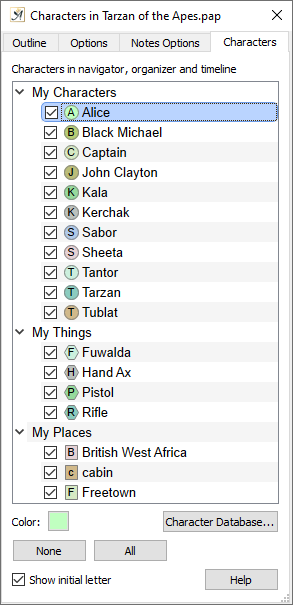
You can choose which character should be shown in the Navigator tab
“My Things” and “My Places” in Your “My Characters” Database
In addition to characters, the “My Things” and “My Places” in your story also have their own tables in the “My Characters” database.
For these tables we have created specific fields, which can be used to create a link to an external document or a website.
These links can even be an audio file or a video that can be played in the media player on your computer.
An internet link will simply save a URL, which will then be opened in your browser.
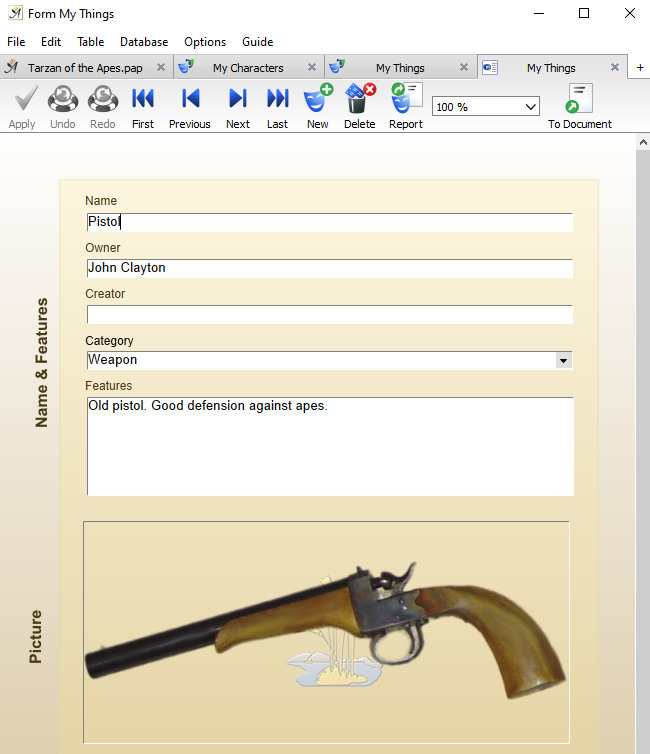
A database entry for a thing, in this case an old gun
